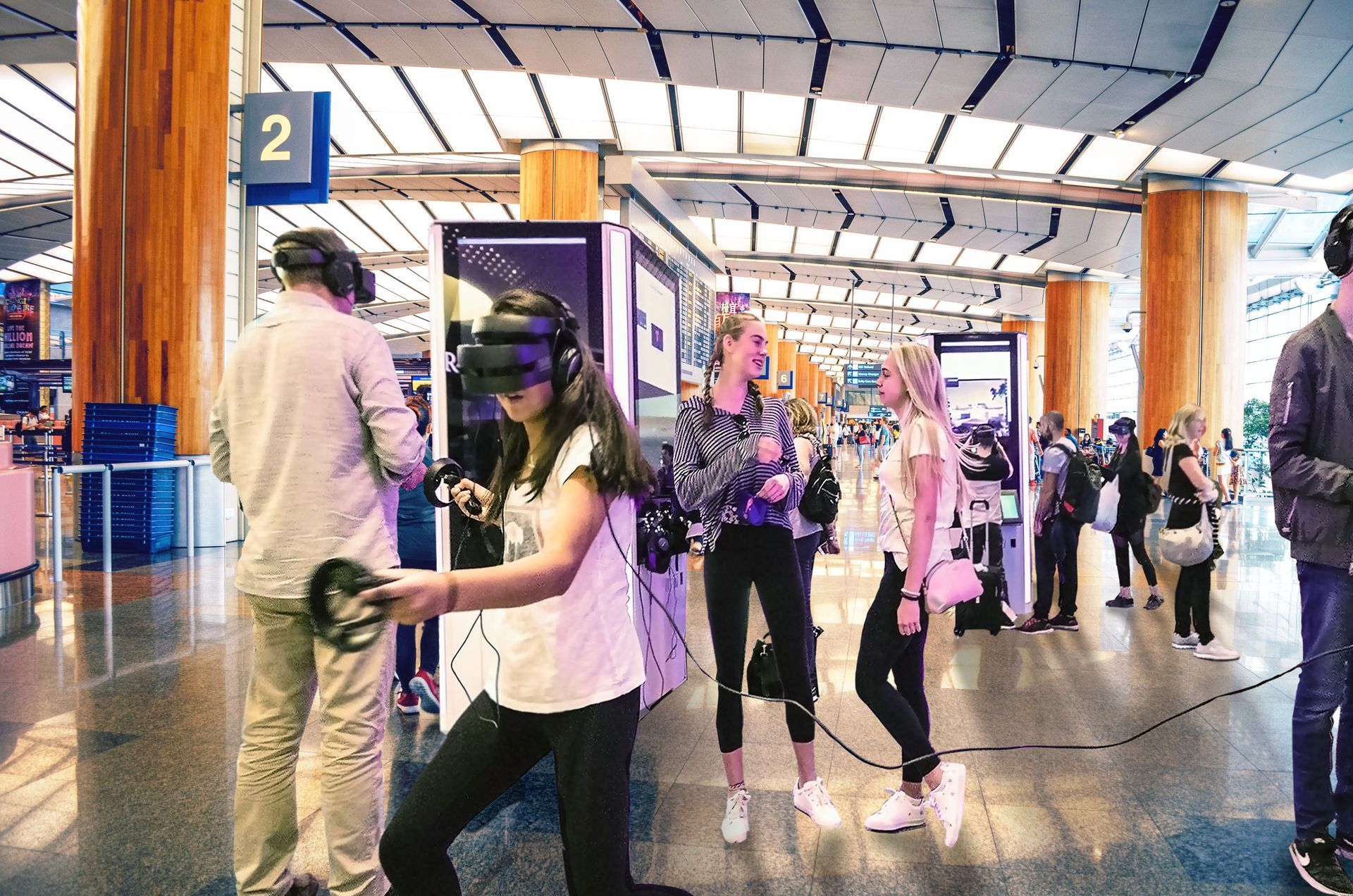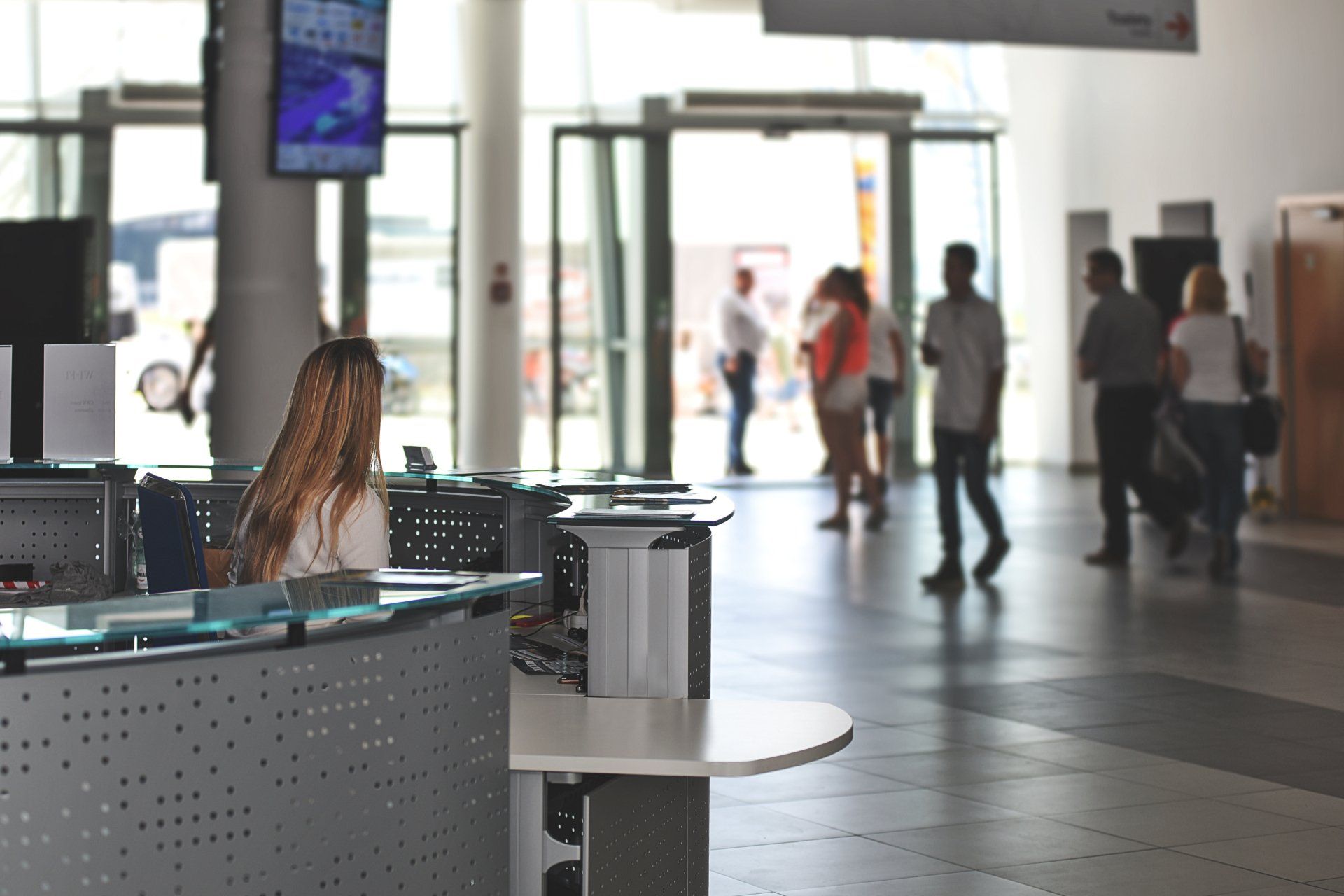Top 5 Trends in Airport Media Advertising
Top 5 Trends in Airport Advertising for 2024 & Beyond

Over the past decades, airport advertising has evolved significantly. Most of the advancement has been driven by technological advancements, changing consumer behaviors, and the unique environment of airports, which presents a captive audience of diverse travelers. In addition, with the growth of air traffic, airports have also become prime locations for brands to market diverse, often affluent audiences. The following article explores the top five airport advertising trend for 2024 and beyond, also highlighting the innovative strategies and technologies that are redefining how top brands engage with travelers.
Digital & Interactive Advertising

One of the top trends in airport advertising is the shift towards digital and interactive formats, which is completely transforming traditional static billboards into dynamic, visually engaging displays. Included in this trend is XR/extended reality, which becomes a virtual world to showcase brands itself using the latest displays, also incorporating Augmented Reality (AR), Virtual Reality (VR) and Mixed Reality (MR). XR is revolutionizing everyday
consumer experiences and transforming diverse industry segments. Digital screens offer several advantages, including:
- Real-Time Content Updates - Digital screens allow brand advertisers to update content in real-time. This responsive process ensures that messages remain relevant and timely. This real-time capability is useful for promotions, seasonal messaging, and to provide news updates, which can be instantly adjusted based on current events or specific audience demographics.
- Interactive Experiences for Diverse Travelers - The latest innovations include interactive kiosks and touchscreens that are quickly becoming commonplace in airports. These engaging and interactive experiences offer travelers methods to participate in games, virtual reality (VR) experiences, and product demonstrations. For example, skincare and beauty brands might use interactive mirrors that allow users to virtually try on makeup, while technology may offer interactive user-experiences, and automotive companies showcase virtual test drives of their latest models.
- Programmatic Advertising - Programmatic advertising involves the use of advertising technology to buy and place digital ads based on real-time data. The automated process applied in programmatic advertising uses defined parameters, to serve up ad impressions within a second. This approach allows advertisers to target specific audiences more effectively through the process of leveraging algorithms and data analytics to deliver ads using data such as flight destinations, traveler demographics, and time of day to optimize ad placements. The results leverage ROI to reach the right audience at the right time.
Personalization & Targeted Advertising

Personalization is now a cornerstone of effective advertising, and airport advertising is no exception. Due to advances in data analytics and artificial intelligence (AI), brands now can deliver
highly targeted and personalized messages to travelers. The results include:
- Data-Driven Insights - Airport advertising data collection involves gathering vast amounts of data on traveler behavior, including flight information, purchase history, and browsing habits. This carefully collected data allows advertisers to create unique, detailed profiles of different traveler segments and tailor their brand messaging accordingly. For example, an educational institution may include stories of recent graduates after landing their first dream job. A high-end fashion brand might target first-class passengers with personalized offers based on their previous shopping history.
- Location-Based Advertising & Geofencing
- Geofencing and location-based technology provides advertisers a method to target travelers based upon specific locations within the airport. By setting up virtual perimeters in specific areas, brands can deliver location-specific advertising to mobile devices. For instance, a coffee shop near boarding gate A might send a discount offer to travelers waiting to board their flights near the gate. Restaurants near boarding gate B may push ads to travelers waiting to board in that specific area. The results provide relevant content to potential customers.
- Beacon Technology
- Beacons are small, wireless transmitters that use low-energy Bluetooth technology to send signals to other smart devices nearby, including smart phones. Beacons are one of the latest technologies in proximity marketing by connecting and transmitting information to smart devices by making location-based searching easier and more accurate. When integrated with an airport's mobile app, beacons can deliver personalized messages and ads directly to travelers as they move throughout the airport. For example, an airport coffee shop may use beacons to alert nearby travelers of a special on cold brew or lattes. A duty-free store might use beacons to alert travelers about special promotions as they walk by toward their boarding gate.
Immersive & Experiential Advertising
Experiential and immersive advertising are frequently used interchangeably to describe ways of creating memorable firsthand experiences for consumers. Experiential marketing is a way for advertisers to connect their brands with customers through hands-on, interactive activities. Using participatory, hands-on, and tangible branding material, advertisers can show consumers not just what the company offers, but what it stands for.
Immersive marketing is a type of experiential marketing that makes an experience immersive, by creating a whole world infused with the brand’s messaging, values, and story. By transporting consumers into mini-worlds full of unexpected images and information, immersive marketing works to surprise and captivate consumers, while informing them about the brand.
These forms of advertising are gaining traction in airports by offering travelers memorable and immersive brand experiences that go beyond traditional advertising.
Pop-Up Stores & Brand Activations
With pop-up stores and activations, brands can launch innovative campaigns that provide consumers an exceptional in-person experience while offering brands a broader reach of attracting prospective customers. Pop-up activations offer advertisers the ability to deliver a novel experience to consumers without having to build a whole new store.
In airports, these temporary setups allow brands to engage directly with travelers, offering product samples, demonstrations, and unique experiences.
Pop-up stores and brand activations are becoming popular in airport terminals. For example, a tech company might set up a pop-up store in an airport to showcase its latest release, accessories, or software upgrades, allowing travelers to test and purchase products on the spot.

Immersive Installations
Immersive media installations, such as virtual reality (VR) and augmented reality (AR), use cutting-edge technology to create captivating experiences. Both VR and AR offer significant opportunities for brand promotion by engaging consumers with sensory, emotional, and perceptual stimuli. In fact, the AR & VR market is projected to generate revenue of $40.4 billion in 2024 and grow at an annual rate of 8.97% through 2029 (Statistica, 2024).
Brands integrating Artificial Intelligence (AI) with AR and VR marketing also generate stronger personalized experiences, as AI algorithms can enable brands to analyze consumer behavior, preferences, and interactions to deliver the most effective content advertising to meet their needs. For example, in airport advertising, an airline might create a VR experience that allows diverse groups of travelers to explore exotic destinations or executive stays before booking their flights. These immersive installations not only attract consumer attention but also provide an engaging way for brands to connect with their audience. Inflight VR experiences provides passengers with a headset loaded with immersive entertainment, including shopping, travel experiences, 3D cinema and games.
Sustainable & Eco-Friendly Advertising
Many airports across the world have adopted green elements and eco-friendly initiatives, which have also engaged brands in focusing on eco-friendly practices and messaging in efforts to appeal to environmentally conscious travelers. With growing awareness of environmental issues, sustainability has become a key consideration in airport advertising.
In a survey conducted on 5,500 travelers in 13 countries, including the US, Canada, UK, Sweden, Spain, Brazil, Japan, China, and more, although air travelers continue to prioritize price and flight connections in 2024,
40% of global travelers are now willing to pay at least 2% more for carbon-neutral airfare (Ahmad et al., 2024).
Additionally, in Spain,
nearly 60% of are willing to pay extra for carbon-neutral flights, compared to 9% in India and 2% in Japan
(Ahmad et al., 2024). With these green trends that are predicted not to fade away any time soon,
airport advertising offers brands a great opportunity to capture and retain the attention of mindful travelers.
In addition, advertisers are incorporating sustainable materials in their visual displays and installations. These eco-friendly materials include biodegradable banners, construction with recycled materials, and energy-efficient lighting for digital screens. By adopting eco-friendly practices, brands are demonstrating their commitment to sustainability that resonate with an increasing number of eco-conscious travelers.
In addition to sustainability in brand messaging, partnerships centered around eco-friendly initiatives are on the rise. These partnerships often involve brands that partner together centered around eco-friendly initiatives to enhance their credibility and commitment to sustainability. For example, a technology company might collaborate with a global agency initiative centered around a recycling program to promote the responsible disposal of electronic waste. These partnerships can be a powerful way to enhance brand credibility relating to commitments toward sustainability, while engaging passionate travelers that care about environmental issues.
Mobile Technology Integration
Integrating airport advertising with mobile technology is also part of the growing trend in airport advertising as mobile devices have become increasingly integral to consumer’s daily life. Mobile integration enhances the effectiveness of advertising campaigns by to delivering targeted advertisements and promotions, while also providing seamless and convenient experiences for travelers. Some of the key areas of mobile technology and airport advertising integration include:
QR codes, mobile payments, social media, and AR.
QR codes are being used to enhance OOH advertising and bridge the gap between physical and digital advertising. According to Statistica, a surge in advertisers leveraging QR technology as part of their OOH campaigns led to a 323% jump in U.S. QR code usage between the years 2021 to 2023
(JCDecaux, 2024).
Facilitated by QR code technology in today’s smartphones, this upswing has improved and simplified the ways that consumers connect from tangible ads to online destinations. Airport travelers can now simply scan QR codes on various ad campaigns, including billboards, posters, and digital screens to access more information, download coupons, or make purchases directly from their mobile devices. This seamless integration is an added convenience for travelers to engage with brands and take advantage of special offers.
Additionally, advertisers are integrating their airport marketing campaigns with social media platforms. By encouraging air travelers to share their experiences on social media, brands can amplify and expand their reach to engage a much wider audience. For example, a photo booth installation at the boarding gates, or by a coffee shop, prompt travelers to share their travel pictures with a specific hashtag, creating organic social media buzz for the brand. Many airports also have their own mobile apps that integrate with mobile devices to offer a range of personalized services, including flight information, to in-flight services, and shopping guides. Brands are leveraging these mobile apps to deliver targeted advertisements and promotions to travel consumers. For example, an airport app might feature AR experiences, in 3D, to provide engaging and visual experiences for executive travelers, including discounts and special offers on products before making a purchase.
Conclusion
Airport advertising has undergone a dynamic transformation, driven by technological innovations, and changing consumer expectations, and continues to evolve. This shift towards engaging digital and interactive advertising formats, with an emphasis on personalization, sustainability, and the rise of experiential marketing, including integration with location-based technology, such as geofencing, are all shaping the future of airport advertising. As these trends continue to evolve, brands are increasingly expected to innovate and remain agile to effectively meet the demands to engage consumers and the diverse audiences that advertising in airports offers.
By leveraging the latest technological trends, brands can create impactful and memorable experiences with audiences that enhances brand visibility and drives consumer engagement. For these reasons, the future of airport advertising is very bright and offers brands diverse opportunities if they embrace new technologies and innovative strategies.

With 25+ years experience, Altitudes Media dedicates itself to literally traveling the world to discover the latest, cutting-edge technologies available, and works with various partners in the US, and abroad. In addition to airport-specific media placement and experiential marketing opportunities, our team has vast experience in media and sponsorship opportunities across many other platforms, including sports and entertainment stadiums, arenas and high traffic private/public venues.
Altitudes Media CEO, Doug McNaughton, and his team, offer proven expertise in the airport and sports sponsorship mediaspace. Altitudes Airport Media is an OOH buying agency, which is solely focused on airport advertising media and sponsorship opportunities. As airports have historically been a very difficult space for companies and advertising agencies to buy, given the nuances and complexities of every airport and its various offerings and opportunities, Altitudes Media has gained the knowledge and expertise to deliver the best results for our clients each and every time.
Altitudes Media clients include a wide range of mid-size to large organizations in a variety of industries. Our minimum advertisement buy ranges from $25K+. Altitudes Media’s team offers our clients decades of experience, solely in the airport advertising space, which eliminates the stress and extra time out of buying airport advertising and also guarantees your company and brand the best units in the best locations at the best rates!
Privacy Policy | All Rights Reserved | Altitudes Media

